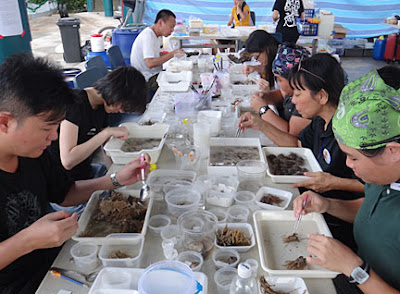Today, we look forward to an evening of talks and dinner at Ubin Town.
Tomorrow is a big day so Kwan Siong has brought along the big projector screen. Which was a handful, until Heok pulls out a much needed handful of cable ties. Hurray!
Jim Wong has also come along with a huge amount of equipment to photograph luminous sea creatures.
 |
| Photo by Jim Wong on facebook. |
Meanwhile Dr Ng Heok Hee is preparing the humungous nets used for sampling for fishes. The low tides are over so there are no more evening field trips. Instead, we look forward to a series of talks by the experts.
Rene Ong shared a special find of the day. A tiny hermit crab on a big sponge crab!
 |
| Photo by Rene Ong on facebook. |
Prof Daphne Fautin has been to Singapore many times for sea anemone work. And so far, she has found about 50 sea anemone species! Singapore has >more sea anemone species than the entire Pacific coast of North America!
This was quite a surprise to her. Singapore is so highly urbanised, it didn't seem probable that we would have so many different kinds of sea anemones.
One of the possible reasons for this high biodiversity is that Singapore lies in the cross-roads of oceans. Of course, she shared lots more about sea anemones and their general distribution, with examples of Singapore species. I always learn so much from even the briefest talks by Prof Daphne.
Dr Ilse Bartsche then shared more about marine mites, teeny tiny creatures that live everywhere in the sea. We learnt from her that marine mites have an extremely low reproduction rate - one generation per year! Singapore's mite count stands at 30 plus species, compared to 80 plus in Perth, Western Australia. She has been going through the water from our surveys to look for these minute creatures!
Dr Fujita Toshihiko then gives a talk aimed at the volunteers, sharing the features of brittle stars and some really awesome creatures. Like these 'Monkey' brittle stars that cling onto other animals.
There are also brittle stars that are found on jellyfishes! Indeed, we do look carefully at the jellyfishes we found during the Expedition to look for hitch hikers like fishes too.
And there are brittle stars that glow in the dark too! Wow!
Dr Fujita also explains why it is not possible to identify brittle stars from a photo. We need to look at the tiny parts of the animal to be able to do so. Here's more of Dr Fujita's talk in Feb 2010.
Dr Prosanta Chakrabarty then gave a fascinating talk where I learnt that although freshwater habitats make up less than 2% of the earth, there are just as many freshwater fish species as marine fishes. Wow.
Among the interesting work he is doing is looking at these little fishes that are bioluminescent. The males can flash at the females. I didn't know that so much could be learnt from studying these common fishes.
After the talks, we head out to Ubin Town to our favourite restaurant run by two sisters. They have the best food on the island!
We made very quick work of all the delicious dishes. The highlight of course being pepper crab and deep fried 'sotong' or squid.
And finally, beer! OBS is an alchol-free location so everyone raised their glasses with joy.
The two sisters' restaurant is also special because of the many photos of Ubin in the past are pasted up on the walls. Here's Chay Hoon explaining a Chinese article about a humungous wild boar.
The grand event of the evening is Bill's first taste of durian. Thanks to Pei Yan for opening the prickly fruit.
Everyone gathers to take photos of this momentous event! And Bill declares that he does like durian.
After the fun, it's back to work sorting before we call it a night.
Tomorrow, we will back bright and early as we are expecting a VIP visit.






















No comments:
Post a Comment